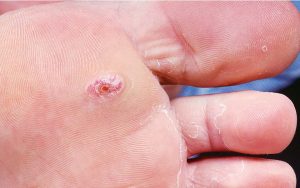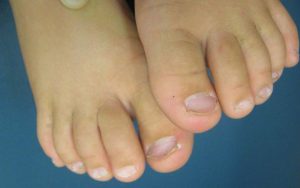Your feet may be revealing more than just dry, flaky, skin! Thyroid disease, heart disease, diabetes, and even some cancers are all quite easily detected from a few simple signs your feet can give you. Read on…
Symptom: Dry, flaky feet
Possible Diagnosis: Thyroid issue
If you consistently moisturise and exfoliate your feet, and you find that your feet remain dry and flaky then this might be a warning sign of thyroid disease. The thyroid gland is a small butterfly shaped gland situated at the back/bottom of your neck which controls your blood pressure, metabolism, nervous system/skeletal/tissue growth. According to podiatrist Marlene Reid, DPM, from Naperville, Illinois this does so by producing certain thyroid hormones and if your thyroid isn’t working the way it should be, a warning sign is almost certainly, dry skin. If moisturising doesn’t fix the problem and you notice that your feet continue to crack, or you have brittle toenails, you’ll need to see your GP for a total body check up.
Symptom: Bald toes
Possible Diagnosis: Arterial disease
If the hair on your toes begins to vanish then this could be a clear cut sign of poor blood circulation. “Peripheral arterial disease or PAD symptoms include decreased hair growth on the feet and ankles, purplish toes, and thin or shiny skin,” states Suzanne Fuchs, PDM of North Shore University Hospital, New York.
PAD is caused by a concentration of plaque building up in your leg arteries and can be determined by taking an X-Ray to check the rate of your foot pulse. Gary A. Pichney, DPM from The Institute for Foot and Ankle Reconstruction at Mercy Medical Center has determined, “If I take an X-ray of a broken foot, and I see a hardening of the arteries, 99 percent of the time, the same thing is happening in the heart blood vessels,” from which hair disappearance is the symptom the patient came in for.

Symptom: Ulcers that don’t heal
Possible Diagnosis: Diabetes
According to Reid, “Uncontrolled glucose levels can damage nerves and cause poor circulation, so blood doesn’t reach the feet. When blood doesn’t get to a wound caused by, say, irritating shoes, the skin doesn’t heal properly. Many people with diabetes are diagnosed first because of foot problems.” There are also other feet related signs that can warn you of whether you have diabetes, including a slight tingling or numb feeling in your feet. Be sure to inquire about a blood sugar level test the next time you visit your GP.
Symptom: Pitted toenails
Possible Diagnosis: Psoriasis
Psoriasis is an autoimmune disease which causes your skin to become irritated and constantly itchy. Most people who endure nail psoriasis are generally experiencing skin psoriasis too but with nails it is different. Nail psoriasis causes your toenails to have little pits or holes in them. If you can notice a difference in your toenails then you definitely need to go get it checked with your GP. If you also notice horizontal lines or white patches across your toenails, those are big signs of psoriasis with which your doctor will be able to prescribe topical creams or injected steroids. Dr. Pichney states that, “If you’ve never been diagnosed with psoriasis, but your toenails have little pits in them, you should get them checked out.”
Symptom: A straight line under your toenails
Possible Diagnosis: Skin cancer
This may sound severe, and perhaps it is. If you have noticed a vertically dark line running underneath your toenail/s then it could be a sign that melanoma (a type of skin cancer) is present. Dr. Pichney advises that, “It will be a black line from the base of your nail to the end of the nail,” and should be seen immediately by your podiatrist or dermatologist to define whether or not you are at risk. Sometimes certain foot fungi can appear this colour but look closer to make sure it is not actually a yellow/brown sporadic pattern throughout the nail, but definitely a vertical line.
Symptom: A suddenly high arch
Possible Diagnosis: Nerve damage.
Most high-arched feet are associated with some form of underlying neuromuscular condition, says Pichney. If someone has thinning of the arch muscles in the foot, it could be an indication of a neurological condition called Charcot-Marie-Tooth (CMT). An inherited disorder that damages the peripheral nerves (those outside the brain and spinal cords), CMT can also cause changes in gait, numbness in the feet, difficulty balancing, loss of muscles in the lower legs, and later on, similar symptoms in the arms and hands. See your doctor if you notice abnormalities. For anything that is different or changes when it comes to the foot, see your podiatrist right away.

Symptom: Club feet
Possible Diagnosis: Lung cancer, heart or intestinal disease
This symptom tends to appear in both your fingers and toes but whichever appendages they appear on, they generally mean one of three things. One is the fact that club feet are associated with lung cancer or infection. Second is the fact club feet are associated with heart disease. Finally, club feet are also associated with intestinal disease so if you are the unlucky person noticing that your feet and hands are becoming clubbed, then book an appointment with your GP as soon as possible! These diseases and infections are not to be taken lightly and result in a physically rounder and wider appearance to begin with, and possibly death later on. Stay safe and ask your doctor to look at any abnormalities.
Symptom: Tiny, red lines under the toenail
Possible Diagnosis: Heart infection
While those little red lines you notice on your toenails don’t seem to be having any effect on you now, it’s usually a sign of burst blood vessels, otherwise known as splinter hemorrhages. Endocarditis is an infection that affects your heart’s inner linings and is most at risk in people who have undergone some pacemaker operations, HIV or cancer treatment and can lead to some serious heart conditions should the symptoms be ignored. If you haven’t seriously stubbed your toe or put some kind of intense pressure on it, visit your GP to get those capillaries looked at as soon as possible!
Symptom: Enlarged, painful big toe
Possible Diagnosis: Excess red meat and alcohol consumption
It’s been found that foods rich in purine concentration tend to raise the natural uric acid levels in your body, which can lead to some very painful gout. Gout is similar to arthritis that focuses on the big toe, leaving it painfully inflamed and swollen. In certain people, uric acid is under or over produced and drinking alcohol or eating a lot of red meat increases the risk of normal uric acid levels being thrown off.
“You’ll see the deposition of the uric acid in the joint, most commonly the big toe or the ankle,” states Bob Baravarian DPM, foot and ankle specialist at Providence Saint John’s Health Center, California. He continues, “The patient will wake up with a hard, red, swollen joint. It’s extremely painful.” Visiting your GP may result in a prescription of anti-inflammatory drugs for some quick and effective relief from your symptoms, and also offer a diet low in purine for some long term relief avoiding future instances.

Symptom: Spooned nails
Possible Diagnosis: Anemia or lupus
This disease can also be known as koilonychias and is where your toenail exhibits a spoon shaped depression deep enough to contain droplets. If this is the case, then you may be suffering from an iron deficiency or (or surplus), Raynaud’s disease (where your finger and toe blood supply is affected), and even lupus. Lupus is when the body’s auto-immune system starts targeting its own cells and tissues. While this is common with most newborns and infants, it ceases over time so if you notice a depression in your toenails, book that appointment with your GP to get a blood test carried out.
Reference: www.rd.com


